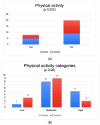Evaluation of Metabolic and Cardiovascular Risk Measured by Laboratory Biomarkers and Cardiopulmonary Exercise Test in Children and Adolescents Recovered from Brain Tumors: The CARMEP Study
- PMID: 38254811
- PMCID: PMC10813808
- DOI: 10.3390/cancers16020324
Evaluation of Metabolic and Cardiovascular Risk Measured by Laboratory Biomarkers and Cardiopulmonary Exercise Test in Children and Adolescents Recovered from Brain Tumors: The CARMEP Study
Abstract
In recent decades, the improvement of treatments and the adoption of therapeutic protocols of international cooperation has led to an improvement in the survival of children affected by brain tumors. However, in parallel with the increase in survival, long-term side effects related to treatments have been observed over time, including the activation of chronic inflammatory processes and metabolic alterations, which can facilitate the onset of metabolic syndrome and increased cardiovascular risk. The aim of this study was to find possible statistically significant differences in the serum concentrations of early biomarkers of metabolic syndrome and in the results of cardiopulmonary exercise testing between survivors of childhood brain tumors and healthy controls. This is a prospective and observational study conducted on a group of 14 male patients who survived childhood brain tumors compared with the same number of healthy controls. The concentrations of early metabolic syndrome biomarkers [adiponectin, leptin, TNF-α, IL-1, IL-6, IL-10, endothelin-1, apolipoprotein B, and lipoprotein (a)] were measured and a cardiopulmonary exercise test (CPET) was performed. Results: Childhood brain tumor survivors performed worse on average than controls on the CPET. Furthermore, they showed higher endothelin-1 values than controls (p = 0.025). The CPET results showed an inverse correlation with leptin. The differences found highlight the greater cardiovascular risk of brain tumor survivors, and radiotherapy could be implicated in the genesis of this greater cardiovascular risk.
Keywords: brain tumor; cardiovascular risk; childhood cancer survivor; cranial radiotherapy; metabolic syndrome.
Conflict of interest statement
The authors declare no conflicts of interest.
Figures
Similar articles
-
Physical fitness and modifiable cardiovascular disease risk factors in survivors of childhood cancer: A report from the SURfit study.Cancer. 2021 May 15;127(10):1690-1698. doi: 10.1002/cncr.33351. Epub 2021 Jan 6. Cancer. 2021. PMID: 33405260
-
Growth hormone deficiency predicts cardiovascular risk in young adults treated for acute lymphoblastic leukemia in childhood.J Clin Endocrinol Metab. 2004 Oct;89(10):5003-12. doi: 10.1210/jc.2004-0126. J Clin Endocrinol Metab. 2004. PMID: 15472198
-
Subclinical Cardiac Dysfunction in Childhood Cancer Survivors on 10-Years Follow-Up Correlates With Cumulative Anthracycline Dose and Is Best Detected by Cardiopulmonary Exercise Testing, Circulating Serum Biomarker, Speckle Tracking Echocardiography, and Tissue Doppler Imaging.Front Pediatr. 2020 Mar 31;8:123. doi: 10.3389/fped.2020.00123. eCollection 2020. Front Pediatr. 2020. PMID: 32296665 Free PMC article.
-
Biomarkers Predictive of Metabolic Syndrome and Cardiovascular Disease in Childhood Cancer Survivors.J Pers Med. 2022 May 27;12(6):880. doi: 10.3390/jpm12060880. J Pers Med. 2022. PMID: 35743665 Free PMC article. Review.
-
Assessment of Exercise Intolerance in Patients with Pre-Dialysis CKD with Cardiopulmonary Function Testing: Translation to Everyday Practice.Am J Nephrol. 2021;52(4):264-278. doi: 10.1159/000515384. Epub 2021 Apr 21. Am J Nephrol. 2021. PMID: 33882502 Review.
Cited by
-
Bioelectrical Impedance Analysis of Body Composition in Male Childhood Brain Tumor Survivors.Diseases. 2024 Nov 28;12(12):306. doi: 10.3390/diseases12120306. Diseases. 2024. PMID: 39727636 Free PMC article.
References
-
- Gatta G., Botta L., Rossi S., Aareleid T., Bielska-Lasota M., Clavel J., Dimitrova N., Jakab Z., Kaatsch P., Lacour B., et al. Childhood Cancer Survival in Europe 1999–2007: Results of EUROCARE-5—A Population-Based Study. Lancet Oncol. 2014;15:35–47. doi: 10.1016/S1470-2045(13)70548-5. - DOI - PubMed
-
- Vassal G., Schrappe M., Pritchard-Jones K., Arnold F., Basset L., Biondi A., Bode G., Eggert A., Hjorth L., Kamerić L., et al. The SIOPE Strategic Plan: A European Cancer Plan for Children and Adolescents. J. Cancer Policy. 2016;8:17–32. doi: 10.1016/j.jcpo.2016.03.007. - DOI
-
- Brock P.R., Knight K.R., Freyer D.R., Campbell K.C., Steyger P.S., Blakley B.W., Rassekh S.R., Chang K.W., Fligor B.J., Rajput K., et al. Platinum-induced ototoxicity in children: A consensus review on mechanisms, predisposition, and protection, including a new International Society of Pediatric Oncology Boston ototoxicity scale. J. Clin. Oncol. 2012;30:2408–2417. doi: 10.1200/JCO.2011.39.1110. - DOI - PMC - PubMed
-
- Sofia R., Melita V., De Vita A., Ruggiero A., Romano A., Attinà G., Birritella L., Lamendola P., Lombardo A., Lanza G.A., et al. Cardiac Surveillance for Early Detection of Late Subclinical Cardiac Dysfunction in Childhood Cancer Survivors after Anthracycline Therapy. Front. Oncol. 2021;11:624057. doi: 10.3389/fonc.2021.624057. - DOI - PMC - PubMed
-
- Weiss A., Sommer G., Kasteler R., Scheinemann K., Grotzer M., Kompis M., Kuehni C.E., Swiss Pediatric Oncology Group (SPOG) Long-term auditory complications after childhood cancer: A report from the Swiss Childhood Cancer Survivor Study. Pediatr. Blood Cancer. 2017;64:364–373. doi: 10.1002/pbc.26212. - DOI - PubMed
LinkOut - more resources
Full Text Sources


